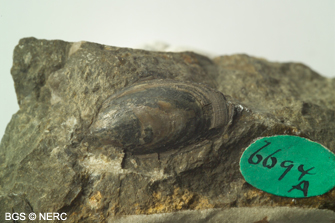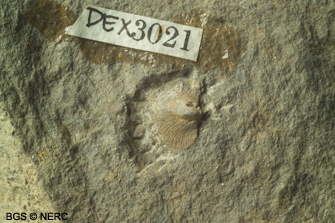
The fossils of Mendip
Silurian | Upper Devonian | Lower Carboniferous | Triassic | Lower to Middle Jurassic
Silurian fossils (444 to 416 million years ago)
Silurian mudstones and tuffs
The Silurian rocks in the Mendips are relatively poor in fossils, their remains mainly occurring in the mudstone-rich lithologies at the base and in a bed of water-lain tuff (consolidated volcanic ash) present in the overlying volcanic succession. The fauna of the shales is dominated by brachiopods, including Isorthis clivosa, Salopina conservatrix, Protochonetes sp. and Eocoelia angelini, the record of the last named species allowing the base of the succession to be assigned to the lower Wenlock part of the Silurian. The fauna from the tuff includes bivalves and the brachiopods Lingula and Salopina conservatrix. Overall the brachiopod fauna suggests that a shallowing of the marine environment occurred near the base of the Silurian succession in the Mendips, perhaps related to local uplift associated with impending Silurian volcanism.


- Home
- Overview maps
- Locality
areas
- Cheddar Gorge
- Charterhouse
- Blackdown
- Burrington Combe
- Shipham & Rowberrow
- Crook Peak & Axbridge
- Banwell to Churchill
- Priddy
- Harptree & Smitham Hill
- Draycott & Westbury-sub-Mendip
- Wookey Hole & Ebbor Gorge
- Wells
- Great Elm & Vallis Vale
- Mells & the Wadbury Valley
- The Vobster area
- The Whatley area
- Torr Works & Asham Wood
- Beacon Hill
- Stoke St Michael & Oakhill
- Holwell & Nunney
- Shepton Mallet & Maesbury
- Gurney Slade & Emborough
- The Nettlebridge valley
- Geology
- Minerals and mines
- Quarrying
- Caves and karst
- Biodiversity
- Detailed site information
- Acknowledgements
- External links
- Search
- Site map